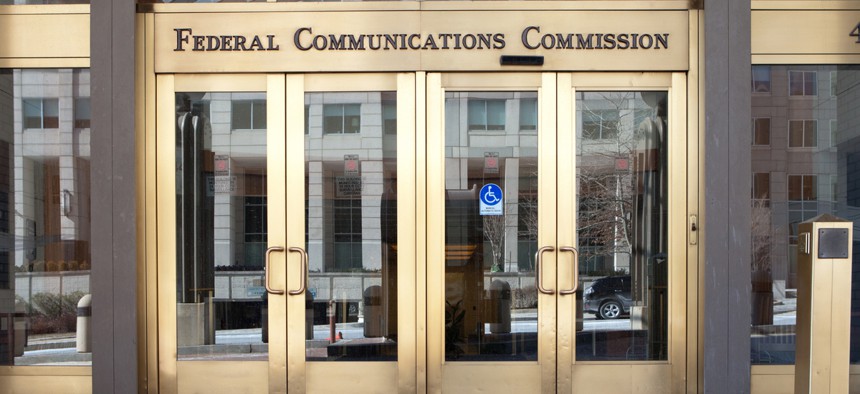FCC Approves New Rule To Limit Local Authority In 5G Rollout

The Federal Communications Commission in Washington, D.C. Shutterstock
Proponents said the order will insure that delivery of faster wireless service occurs in more areas more quickly, but a key opponent called it “extraordinary federal overreach.”
Although the Federal Communications Commission moved forward Wednesday with an order curtailing local governments’ authority to regulate the rollout of fifth-generation wireless, jurisdictions are now looking at months of uncertainty over when the new rules will be implemented.
The rule sets strict approval times for governments to consider permits and caps the fees jurisdictions can charge providers.
All major state and local organizations opposed the measure, despite its anticipated approval, and are expected to petition the FCC for reconsideration—possibly followed by lawsuits, said Angelina Panettieri, principal associate for technology and communications at the National League of Cities.
“We didn’t see a lot of advocates for local government on the dais today,” Panettieri told Route Fifty. “This order is going to increase the amount of litigation around small cell proposals.”
Commissioner Brendan Carr, a Republican, introduced the rule earlier this month promising providers would save $2 billion on unnecessary fees while speeding up the release of the much-faster 5G service to cities and underserved rural and suburban communities.
Carr and other proponents have argued that smoothing the regulatory path for 5G will help bring broadband internet service to places that currently don’t have access. And they have emphasized that the U.S. is currently in a battle with foreign competitors to move on 5G.
“We need a concrete plan to close the gap with China and win the race to 5G,” Carr said prior to the vote. “We take this seriously at the FCC, and we are getting the government out of the way so that the private sector can invest and compete.”
Critics have been skeptical, saying that instead cities should be allowed to use their clout to expand infrastructure to neighborhoods where the market hasn’t gone.
The measure, approved 3-1 along party lines, gives jurisdictions 60 days to approve small cells—radio equipment and antennas inside metal boxes—if they are being attached to existing poles. Governments can take 90 days for entirely new poles.
Commissioners said localities will be granted leeway to update their procedures, but it is unclear whether that means an extension or a stay on the rule’s effective date—it generally takes a week to several months for the FCC to post final orders to the Federal Register.
Even Commissioner Jessica Rosenworcel, a key critic of the proposal, celebrated the shorter timeframes for permit approval, to the dismay of local government advocates. But that’s where agreement ended among the FCC commissioners.
“Three unelected officials on this dais are telling state and local leaders all across the country what they can and cannot do in their own backyards,” said Rosenworcel, a Democrat and the lone dissenter. “This is extraordinary federal overreach, and I don’t believe that the law permits Washington to run roughshod over state and local authority like this. And I worry that the litigation that follows will only slow our 5G future.”
One point of contention will undoubtedly be the FCC’s three-part test to determine if a locality’s regulations about the aesthetics of the infrastructure should be preempted, Panettieri said, because providers and governments aren’t likely to see eye-to-eye on what constitutes “reasonable” demands. Despite the scaled-down small cell equipment, residents still notice—and complain to local officials—when new attachments appear on poles.
The places to watch are jurisdictions where 5G agreements are already in place like San José, California, which is working with three providers on the largest small cell-driven broadband deployment in the U.S. A portion of the providers’ investments will go into a digital inclusion fund to expand service to remote parts of the city.
Rosenworcel worried the FCC’s declaratory ruling might undermine all such agreements, and Panettieri said the number of providers that go to court seeking expedited relief in the coming months will “give us an idea of how aggressively they’ll approach this going forward.”
San José Mayor Sam Liccardo criticized the order in a statement.
“Rather than encouraging balanced, common-sense recommendations that advance equitable broadband infrastructure deployment, the FCC’s move will force taxpayers to subsidize industry access to publicly-owned infrastructure—with no obligation to serve the 34 million Americans in low-income and rural communities who remain on the wrong side of the “digital divide,” Liccardo said. “We will consider all of our legal and political options to ensure that the voices of local communities are heard, to achieve a more inclusive vision of our digital future.”
State and local governments had already been at odds about 5G, with about 20 states preempting local authority when it comes to negotiating with providers. The order doesn’t preempt any of those laws.
Local government application fees are typically tied to review costs, but the order calls for a $500 single, up-front application fee including up to “five small wireless facilities”—and $100 per each one after.
A new annual rent ceiling on recurring charges for placing wireless facilities on public property shortchanges jurisdictions, critics said.
The rule requires $270 per small wireless facility per year, including right-of-way access fees and attachment fees. That’s down from the national average of $500 per pole providers pay annually, according to a report from the FCC’s Broadband Deployment Advisory Committee, or BDAC, and the order won’t preempt states with extremely low rent limits like Arizona.
Generally a provider pays for every attachment to a small cell to a pole, even ones already occupied by competitors.
“To be sure, there are some local governments that don’t like this order; they would like to continue extracting as much money as possible in fees from the private sector and forcing companies to navigate a maze of unnecessary hurdles to deploy wireless infrastructure,” said FCC Chairman Ajit Pai, a Republican. “These actions are not only unlawful but shortsighted. They slow the construction of 5G networks and will delay, if not prevent, the benefits of 5G from reaching American consumers.”
Commissioner Michael O’Rielly, a Republican, hinted at additional infrastructure “updates” to the order to be made by the FCC at a later date. Providers should have the ability to challenge fees they believe are not cost-based, he said.
Moving forward, the FCC should develop 5G model codes in lockstep with states and localities, Rosenworcel said. The BDAC plans to finalize a model code in October for states looking to craft their own legislation.
But the last draft included an article intended to discourage municipal broadband networks, meaning the code could be “potentially much more harmful to local governments,” Panettieri said.
“We’re trying to minimize the damage from that state model code that builds on what the FCC and a number of states have already done,” she said.
Dave Nyczepir is a News Editor at Government Executive’s Route Fifty and is based in Washington, D.C.
NEXT STORY: Michigan Has a Growing Salt-Water Problem






